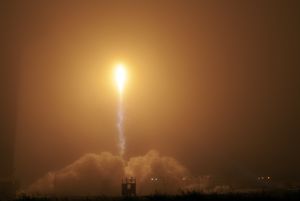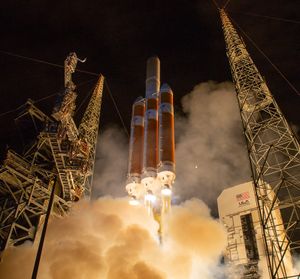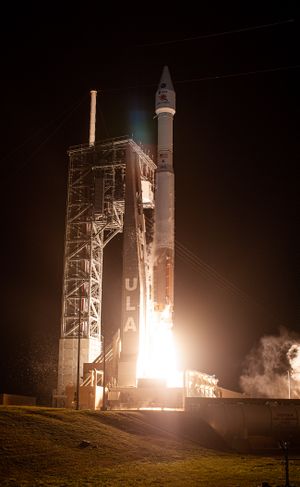ائتلاف الإطلاق المتحد
 | |
 Atlas V 551 launch with Juno spacecraft | |
الاسم المحلي | United Launch Alliance |
|---|---|
| النوع | خاصة |
| الصناعة | الطيران الفضائي |
| تأسست | 1 ديسمبر 2006 |
| المقر الرئيسي | سنتنيال، كولورادو، الولايات المتحدة |
الأشخاص الرئيسيون | توري برونو (الرئيس التنفيذي) |
| المنتجات |
|
| الدخل | US$1٫3 billion (2022)[1] |
| US$200 million (2022)[1] | |
| المالك | Lockheed Martin Space (50%) Boeing Defense, Space & Security (50%) |
| الموظفون | 2,700 (2024) |
| الموقع الإلكتروني | ulalaunch |
ائتلاف الإطلاق المتحد (United Launch Alliance، اختصاراً ULA)، هي مزود خدمات إطلاق للمركبات الفضائية، تُصنع وتُشغل عدداً من المركبات الصاروخية القادرة على إطلاق المركبات الفضائية إلى المدارات حول الأرض وإلى أجرام أخرى في النظام الشمسي. تأسست الشركة، وهي شركة محاصة بين لوكهيد مارتن سپيس وبوينگ للدفاع والفضاء والأمن، في ديسمبر 2006. تشمل قائمة عملاء الإطلاق للحكومة الأمريكية وزارة الدفاع، الإدارة الوطنية للملاحة الفضائية والفضاء (ناسا)، ومنظمات أخرى.[2]
تقدم الشركة خدمات الإطلاق باستخدام نظامي اطلاق متعددي المراحل دلتا 4 الثقيل وأطلس 5، حتى عام 2018، نظام الإطلاق متوسطة الحمولة دلتا 2. أطلقت أنظمة الإطلاق أطلس، ودلتا 4 الثقيل، ودلتا 4 التي أُحيلت إلى التقاعد مؤخراً حمولات تشمل سواتل صناعية للطقس، والاتصالات، والأمن القومي، ومسبارات علمية، ومركبات مدارية. كما تطلق الشركة سواتل تجارية.[3]
اعتباراً من عام 2020، تعمل الشركة على تطوير الصاروخ ڤولكان سنتور، وهو خليفة للصاروخ أطلس 5 الذي يتضمن بعض تقنيات دلتا 4.[4][5] اعتباراً من عام 2019، كان من المقرر أن تبدأ عمليات إطلاق ڤولكان في 2021.[6] من المقرر أن تحل المرحلة المتقدمة للتبريد العميق (ACES) محل سنتور 5 على الصاروخ ڤولكان اعتباراً من عام 2023.[7][8]
تاريخ الشركة
التشكيل وموافقة مفوضية التجارة الفدرالية
Boeing and Lockheed Martin announced on 2 May 2005 that they would establish a 50/50 joint venture, United Launch Alliance (ULA), to consolidate their space launch operations.[9]
The two companies had long competed for launch services contracts from the DoD, and their Atlas and Delta rockets were the two launch vehicles selected under the Evolved Expendable Launch Vehicle (EELV) program. The DoD had hoped the program would foster the creation of a strong, competitive commercial launch market. However, both companies said that this competition had made space launches unprofitable.[10] Boeing's future in the program was also threatened in 2003 when it was found to be in possession of proprietary documents from Lockheed Martin.[11][12] To end litigation and competition, both companies agreed to form the ULA joint venture. During the renewal of the EELV contract, the DoD said the merger would provide annual cost savings of $100–150 million.[13]
SpaceX attempted to challenge the merger on anti-trust grounds, saying it would create a space launch monopoly.[14] The Federal Trade Commission ultimately granted ULA anti-trust clearance, prioritizing national security access to space over potential competition concerns.[15][16]
عهد مايكل گاس (2005–2014)
Michael Gass was announced as the first CEO of ULA and oversaw the merger of the two groups. Production was consolidated into one central plant in Decatur, Alabama while all engineering was moved into a facility in Littleton, Colorado.[17] The parent companies retained responsibility for marketing and sales of the Delta and Atlas rockets.
Cost pressures led ULA to announce it would lay off 350 of its 4,200 workers in early 2009,[18][19] and decommissioned two of its seven launch pads.[13][20] ULA also joined and later left the Commercial Spaceflight Federation during this period.[21][22]
The introduction of lower-cost competition and rising ULA launch costs attracted scrutiny. ULA's reliance on government funding for launch readiness, including maintaining multiple launchpads and rocket variants, became a point of discussion, particularly as the EELV program experienced a cost breach in 2012.[11]
ULA was awarded a DoD contract in December 2013 to provide 36 rocket cores for up to 28 launches. The award drew protest from SpaceX, which said the cost of ULA's launches were approximately US$460 million each and proposed a price of US$90 million to provide similar launches.[23] In response, Gass said ULA's average launch price was US$225 million, with future launches as low as US$100 million.[24]
عهد توري برونو (2014 فصاعداً)
In a leadership change at ULA in August 2014, Tory Bruno assumed the CEO position, marking a new strategic direction for the company.[25] Under Bruno's leadership, ULA was under pressure to reduce costs to better compete with SpaceX and its partially reusable rockets, replace its Russian-made RD-180 with more efficient western-made engines,[26] and introduce a next-generation launch vehicle. The company's high cost to launch left the company with few commercial and civil satellite launch customers, and increasingly reliant on U.S. military and spy agency contracts.[27][28] After the Russian annexation of Crimea in 2014, Congress passed a law in 2016 that prohibited the military from procuring additional launch services on vehicles that use the RD-180 engine after 2022.[29]
To reduce costs, ULA undertook a significant restructuring to streamlining operations by eventually consolidating from five launchpads to two,[30] and reducing its workforce from 3,600 to 2,500 by 2018.[28][31][32] To develop a new engine, ULA announced it would be partnering with Blue Origin to develop the BE-4.[33] The company also announced the Vulcan, a next-generation launch vehicle, to be funded through a public-private partnership. Bruno believed the Vulcan would offer costs that would make it competitive in the commercial satellite sector.[28]
However, despite these cost-cutting measures, ULA launches continued to be more expensive than those offered by SpaceX.[28] The company's joint bid with Dynetics to develop a lunar lander for NASA was rejected in 2021 with the agency calling the companies bid "low in readiness."[34]
The Delta family of rockets was retired in early 2024, having been replaced in the market by the SpaceX's Falcon Heavy, which was more powerful, less expensive, and faster to build, leading ULA to lose all commercial contracts.[10] ULA planned an orderly retirement and had procured and had in hand 100 of the engines to continue building Atlas V as it developed a replacement rocket. At the time of the announcement they could fly 29 more missions and all of them had been sold, so no new orders would be accepted.
ULA faces an uncertain future. In 2023, the company announced that it was for sale.[35] In December 2023, it was announced that Jeff Bezos was looking at purchasing the company to merge it with Blue Origin, which he also owns.[35][36][37]
تاريخ الإطلاق
- Success
- Partial Failure
- Scheduled
2015–2019
2020
البنية التحتية
منشآت الإطلاق

اعتبارا من يونيو 2024[تحديث], ULA operates two launch facilities: Space Launch Complex 41 at the Cape Canaveral Space Force Station in Cape Canaveral, Florida[38][39] and Space Launch Complex 3 at the Vandenberg Space Force Base near Lompoc, California.[40][41] The Cape Canaveral facility is equipped with a crew access arm for loading manned vehicles. Launches from Cape Canaveral typically head east to give satellites extra momentum from the rotation of the Earth as they head to other planets or into an equatorial orbit. Vandenberg is the primary U.S. launch site from which imaging and weather satellites are sent into polar orbits to cover the entire globe.[42]
Since its foundation in 2006, ULA has significantly reduced its number of launch facilities from seven to the current two. At Cape Canaveral it previously operated two pads at Space Launch Complex 17 and one pad at Space Launch Complex 37 for Delta launches.[43][44] At Vandenburg, it previously operated one pad at Space Launch Complex 2[45] and another at Space Launch Complex 6 for Delta launches.[46][47]
المقر الرئيسي والتصنيع
ULA's headquarters in Centennial, Colorado is responsible for program management, rocket engineering, testing, and launch support functions.[48] ULA's largest factory is 1.6 million square feet (150,000 m2) and located in Decatur, Alabama.[49] In 2015, the company announced the opening of an engineering and propulsion test center in Pueblo, Colorado.[50]
Until 2024, the company previously operated a factory in Harlingen, Texas to fabricate and assemble components for the Atlas V rocket.[51]
مركز عمليات الإعداد لارتياد الفضاء
The Spaceflight Processing Operations Center (SPOC), located near Cape Canaveral Space Launch Complex 41 is used to construct the mobile launcher platform (MLP) for the Vulcan Centaur. It also serves as a storage area for the Atlas V MLP.[52] On 6 August 2019, the first two parts of Vulcan's MLP were transported to the SPOC.[53] SPOC was formerly known as the Solid Motor Assembly and Readiness Facility (SMARF) during its support of the Titan IVB launch vehicle; it was renamed during a ceremony in October 2019.[52]
انظر أيضاً
- Aerojet Rocketdyne (RS-68 and RL10)
- Blue Origin (BE-4)
- National Security Space Launch
- Northrop Grumman Innovation Systems (Graphite-Epoxy Motor)
- RUAG Space (payload fairings, composite structures)
- منتجات سابقة
- مزودو خدمات الإطلاق
ملاحظات
المصادر
- ^ أ ب Smith, Rich (2023-03-23). "United Launch Alliance Is For Sale: How Much Is It Worth?". The Motley Fool (in الإنجليزية). Retrieved 2024-06-17.
- ^ "SpaceX breaks Boeing-Lockheed monopoly on military space launches". Reuters. 2016-04-28. Retrieved 2016-04-29.
- ^ Justin Ray (November 23, 2009). "Atlas 5 launches Intelsat communications satellite". Spaceflight Now.
- ^ Gruss, Mike (April 13, 2015). "ULA's Next Rocket to Be Named Vulcan". SpaceNews. Retrieved July 30, 2018.
- ^ Grush, Loren (September 27, 2018). "Military's primary launch provider picks Blue Origin's new engine for future rocket". The Verge. Retrieved October 3, 2018.
- ^ "SNC Selects ULA for Dream Chaser® Spacecraft Launches: NASA Missions to Begin in 2021". ULALaunch. 14 August 2019. Retrieved 14 August 2019.
- ^ Gruss, Mike (13 April 2015). "ULA's Vulcan Rocket To be Rolled out in Stages". Space News. Retrieved 6 March 2016.
- ^ Butler, Amy (11 May 2015). "Industry Team Hopes To Resurrect Atlas V Post RD-180". Aviation Week & Space Technology. Archived from the original on 12 May 2015. Retrieved 6 March 2016.
- ^ "Boeing, Lockheed Martin to Form Launch Services Joint Venture". United Launch Alliance. 2 May 2005. Archived from the original on 17 April 2019. Retrieved 17 April 2019.
- ^ أ ب Kurkowski, Seth (9 April 2024). "Why is ULA retiring the Delta IV Heavy?". Space Explored. Retrieved 17 June 2024.
- ^ أ ب "National Security Space Launch at a Crossroads" (PDF). Congressional Research Service. May 13, 2016. Retrieved August 5, 2020.
- ^ Bowermaster, David (January 9, 2005). "Boeing probe intensifies over secret Lockheed papers". Seattle Times. Archived from the original on 2017-03-12. Retrieved 2020-05-07.
- ^ أ ب Berger, Eric (2017-08-02). "How America's two greatest rocket companies battled from the beginning". Ars Technica. Retrieved 2020-04-18.
- ^ Morris, David Z. (2017-06-17). "Is SpaceX Undercutting the Competition Even More Than Anyone Thought?". Fortune. Archived from the original on 25 January 2019. Retrieved 17 April 2020.
- ^ "FTC gives clearance to United Launch Alliance". Spaceflight Now. October 3, 2006.
- ^ Mergers and Acquisitions: Understanding the Antitrust Issues (3rd ed.). Chicago, Illinois: ABA Section of Antitrust Law. 2008. ISBN 978-1-60442-046-3. OCLC 213864774.
- ^ Erwin, Sandra; Henry, Caleb (24 January 2018). "To stay competitive in the launch business, ULA courts commercial customers". SpaceNews. Retrieved 2018-06-25.
- ^ "United Launch Alliance plans layoffs". Denver Business Journal. 2008-11-14. Retrieved 2014-11-16.
- ^ Avery, Greg (2009-08-05). "ULA seeks land for a combined HQ". Denver Business Journal. Retrieved 2014-11-16.
- ^ Graham, William (2 July 2014). "ULA Delta II successfully lofts OCO-2 to orbit". NASA Spaceflight. Retrieved 22 February 2015.
- ^ "Membership". Commercial Spaceflight Federation. 2014-05-13. Archived from the original on 2014-05-13. Retrieved 2020-05-07.
- ^ Johnson, Alexandra (June 21, 2010). "United Launch Alliance Joins the Commercial Spaceflight Federation". Commercial Spaceflight Federation. Retrieved 2020-05-07.
- ^ Leopold, George (April 28, 2014). "SpaceX launches protest of Air Force rocket contract". Defense Systems. Archived from the original on 6 October 2014. Retrieved 3 October 2014.
- ^ Gurss, Mike (May 20, 2014). "Responding to Critics, ULA Discloses Pricing Information". SpaceNews. Archived from the original on 23 May 2014.
- ^ Gruss, Mike (2014-08-12). "United Launch Alliance Taps a Lockheed Executive To Replace CEO Gass". SpaceNews. Archived from the original on 13 August 2014. Retrieved 2014-08-13.
- ^ Petersen, Melody (2014-12-12). "Congress OKs bill banning purchases of Russian-made rocket engines". Los Angeles Times. Archived from the original on 2017-03-07. Retrieved 2014-12-14.
Costs of launching military satellites has skyrocketed under contracts the Air Force has given to United Launch Alliance. The average cost for each launch using rockets from Boeing and Lockheed has soared to US$420 million, according to an analysis by the Government Accountability Office.
- ^ Shalal, Andrea (21 May 2015). "Lockheed-Boeing rocket venture needs commercial orders to survive". Yahoo! News. Archived from the original on 2015-07-23.
- ^ أ ب ت ث Avery, Greg (2014-10-16). "ULA plans new rocket, restructuring to cut launch costs in half". Denver Business Journal. Archived from the original on 2017-03-15. Retrieved 2014-11-14.
- ^ Erwin, Sandra (19 August 2021). "National security launch in transition as Space Force waits for Vulcan". Space News. Retrieved 16 June 2024.
- ^ Butler, Amy (17 February 2015). "New Rocket, White Tails In ULA's Long-Term Strategy". Aviation Week. Archived from the original on 5 June 2017. Retrieved 22 February 2015.
[the] plan to field a new rocket engine with Blue Origin called the BE-4 is only step one of a larger strategic plan to take the company from a sole-source benefactor mentality to competing in a burgeoning commercial market ... The Atlas V and Delta IV ... both have a limited future.
- ^ Delgado, Laura M. (2014-11-14). "ULA's Tory Bruno Vows To Transform Company". Space Policy Online. Archived from the original on 2014-11-29. Retrieved 2014-11-14.
- ^ "About ULA". United Launch Alliance. Archived from the original on 10 February 2019. Retrieved 17 April 2019.
- ^ Ferster, Warren (2014-09-17). "ULA To Invest in Blue Origin Engine as RD-180 Replacement". SpaceNews. Archived from the original on 18 September 2014. Retrieved 2014-12-13.
- ^ Foust, Jeff (16 April 2021). "NASA selects SpaceX to develop crewed lunar lander". SpaceNews. Archived from the original on 23 May 2021. Retrieved 20 November 2022.
- ^ أ ب Whitwam, Ryan (22 February 2024). "Blue Origin May Buy United Launch Alliance, Putting Pressure on SpaceX". Extreme Tech. Retrieved 6 March 2024.
- ^ "Jeff Bezos Looks to Acquire Rocket Giant ULA In Latest Billionaire Space Race Move". Observer (in الإنجليزية الأمريكية). 2023-12-21. Retrieved 2024-03-06.
- ^ Berger, Eric (2024-02-21). "Blue Origin has emerged as the likely buyer for United Launch Alliance". Ars Technica (in الإنجليزية الأمريكية). Retrieved 2024-03-06.
- ^ Graham, William (August 29, 2012). "Atlas V launches at the third attempt with RBSP spacecraft". NASA Spaceflight. Retrieved June 5, 2018.
- ^ Graham, William (October 15, 2017). "Atlas V successfully launches with NROL-52". NASA Spaceflight. Retrieved June 5, 2018.
- ^ Graham, William (April 14, 2018). "ULA Atlas V successfully launches with AFSPC-11". NASA Spaceflight. Retrieved July 30, 2018.
- ^ Howell, Elizabeth (April 9, 2018). "Atlas V: Reliable, Flexible Rocket". Space.com. Retrieved June 5, 2018.
- ^ Dean, James (December 31, 2017). "Southbound? Cape rockets may fly new path toward poles". Florida Today. Retrieved November 13, 2018.
- ^ خطأ استشهاد: وسم
<ref>غير صحيح؛ لا نص تم توفيره للمراجع المسماةWGS9 - ^ Graham, William (May 27, 2010). "Delta IV finally launches with GPS IIF SV-1 following scrubs". NASA Spaceflight. Retrieved June 5, 2018.
- ^ Foust, Jeff (2 May 2018). "Firefly Aerospace to take over Vandenberg Delta 2 pad". SpaceNews. Retrieved 22 November 2020.
- ^ Howell, Elizabeth (September 21, 2016). "Vandenberg: West Coast Launch Site". Space.com. Retrieved June 5, 2018.
- ^ Clark, Stephen (September 23, 2002). "Historic launch pad faces uncertain future after final West Coast Delta 4 mission – Spaceflight Now" (in الإنجليزية الأمريكية). Retrieved June 25, 2023.
- ^ Avery, Greg (April 5, 2010). "United Launch Alliance to stay in Centennial area at expanded HQ campus". Denver Business Journal. Retrieved August 9, 2018.
- ^ Clines, Keith (February 26, 2017). "ULA rocket plant a boost to Decatur's image". The Decatur Daily. Retrieved November 13, 2018.
- ^ Wallace, Alicia (July 24, 2015). "Pueblo lands United Launch Alliance rocket R&D operation". The Denver Post. Retrieved November 13, 2018.
- ^ Kelley, Rick (April 14, 2017). "ULA to cut workforce by 875 workers". Valley Morning Star. Retrieved November 13, 2018.[dead link]
- ^ أ ب "Construction milestone achieved for Vulcan's launch platform". United Launch Alliance. October 24, 2019. Retrieved 2020-03-28.
- ^ @ToryBruno (6 August 2019). "Mighty Atlas is not the only thing rolling at the Cape today. Check the new Vulcan MLP arrival" (Tweet) – via Twitter.
{{cite web}}: Cite has empty unknown parameter:|dead-url=(help)
وصلات خارجية
- Official website
- Distributed Launch - Enabling Beyond LEO Missions, a ULA take on propellant depots and propellant-cargo launches, September 2015.
- Launch Vehicle Recovery and Reuse, AIAA paper, 2015.
- Free CubeSat rideshares offered by ULA for Atlas V launches, November 2015.
- Boeing, Lockheed Martin to Form Launch Services Joint Venture
- FTC gives prelimanary clearance to United Launch Alliance
- United Launch Alliance begins Operations
- "U.S. Rocket Supplier Looks to Break 'Short Leash'", The Wall Street Journal, 19 July 2015.
- CS1 الإنجليزية الأمريكية-language sources (en-us)
- Articles with dead external links from August 2023
- Short description is different from Wikidata
- Pages using infobox company with unknown parameters
- Articles with hatnote templates targeting a nonexistent page
- مقالات فيها عبارات متقادمة منذ يونيو 2024
- جميع المقالات التي فيها عبارات متقادمة
- Portal templates with default image
- Official website different in Wikidata and Wikipedia
- ائتلاف الإطلاق المتحد
- تأسيسات 2006 في كلورادو
- بوينگ
- مزودو خدات إطلاق تجارية
- شركات مقرها ألباما
- شركات مقرها سنتنيال، كلورادو
- شركات محاصة
- لوكهيد مارتن
- شركات اتفاقية قانون الفضاء
- منظمات الفاء
- شركات تكنولوجيا تأسست في 2006







